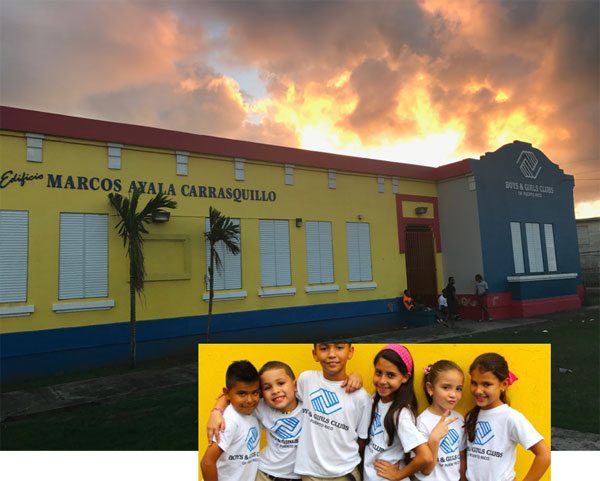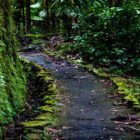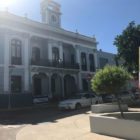
This week, NPQ will be running a series of articles on Puerto Rican nonprofits and how they’re operating and thinking in the wake of Hurricane Maria. It’s part of our effort to illuminate the processes of building anew and recreating from disaster in a region where inequity is already extreme. More generally, the stories provide a glimpse of the vision, reality, and experiences of those affected most by a devastating combination of growing global economic inequality, environmental change, and democratic failures. Because of that, we hope they will be useful far beyond the boundaries of Puerto Rico and its supporters.
We expect this series to be of interest to nonprofits, infrastructure organizations, and funders alike, so please help us distribute it. We expect to continue this conversation well into the future, so we welcome your comments and feedback. Many of you have already shared how the articles in this series to date have helped you better understand the complexities of the situation, the choices that need to be consciously made, and the prominent role nonprofits play.
As we walk through the brightly painted building of the Boys & Girls Club in Loiza, Olga Ramos, president of the Boys & Girls Clubs of Puerto Rico, shows me the play field, which has been closed off with particle board because the dirt is contaminated from when the ocean water mixed with sewer water and spread through the town.
Like many other Boys & Girls Clubs, this one offers activities related to education and the arts to youth ages six through 18, or from first grade through high school graduation. It has educational classrooms; a media lab where young people create journalistic articles, short films, and nonprofit media campaigns; a radio lab where they can do radio interviews; a social room for interactive games; and more. Before Maria, 58 percent of children in Puerto Rico lived in poverty, but 89 percent of the Club’s participants did. So, it offers all of its service—Monday through Friday, three to eight in the evening—at no charge.
Puerto Rico’s colonial status is inescapable and reflected in the stories in this series. It’s one thing that differentiates this center from the ones I’ve visited in the US. For José Luis Vargas, the Media Lab Director, media images are important for this population because the portrayal of Loiza, which is the poorest and blackest municipality in Puerto Rico, is based on a paradigm that needs rethinking. He says he tells his students, “If you want people to really understand what Loiza is about, you have to do it.”
He notes that Loiza is a microcosm of Puerto Rico, meaning that the dominant thinking of the US vis-à-vis Puerto Ricans is replicated within the island between Puerto Ricans in general and those from Loiza. In other words, Puerto Rico is a multiracial society with its own version of race relations, alongside a strong national identity.
He admits, “I feel the same about Puerto Ricans. You understand? It’s like Loiza is a mirror somehow.”
What Vargas refers to is the constant process of replication of the other. Puerto Ricans are “other” to the US, and that positioning is unrelenting in its daily assaults. Puerto Ricans know it, see it, feel it…and recreate it internally with its poor and its black. And Loiza is the center of the poor, black other.
“When you get them at 14–18, it’s a struggle. I can understand that because they’re still developing their personality and that’s not an easy thing to do. But if you can intervene when they’re maybe 8–12, then there’s a good chance that you have more of an opportunity to intervene in this narrative. That’s the job that the Boys & Girls Club is doing.” José Luis is connecting the subordinate consciousness that often results from colonial relationships to the economic poverty they create as well. These complex social dynamics are part of the challenges Puerto Rico nonprofits like the Clubs seek to address.
Though Puerto Rico is affiliated with the Boys & Girls Clubs of America, it has the openness to adjust its programs to the island’s needs. According to Ramos, the mainland US clubs focus more on prevention services, but it focuses on developing youth to be able to find jobs when they leave. In other words, like almost every other nonprofit I visited, the Club focuses on economic development. Many of the nonprofit leaders I met said most of the island’s social problems trace back to poverty, and the island’s high poverty levels trace back to Puerto Rico’s colonial economy—that is, an economy that serves the US more than it serves Puerto Rico.
Ramos shares that it was Hurricane Irma, which came two weeks before Maria, that first gave her and the Clubs a glimpse of what they really needed to do in their communities. The staff went door to door, distributing food, water, and clothing. Three weeks after Maria, the staff went out into their communities again, this time to assess damages. Ramos remembers, “For us, as an organization, we knew the reality of the community, but we had never, up to now, had the opportunity to go in those houses and see for ourselves how people were living.”
She goes on,
Our kids, if you look around, they’re well dressed, they’re happy, they’re well groomed, but then when you go to their houses…There were houses that already [before the hurricanes] didn’t have windows, or doors, or floors, or a complete bathroom, or a shower. These are the conditions they are used to living, not now only after Maria. Maria just uncovered some realities that were there. In Puerto Rico, we talk about poverty, but as a country, we do not like to say what poverty really is. We have people in Puerto Rico that go to bed without having something to eat.
My guide, Nirvana González Rosa, coordinator of the nonprofit network Single Voice Movement (Movimiento Una Sola Voz), agrees. “They don’t want to admit it because to admit that level of poverty in Puerto Rico means the failure of all governments.”
Like other Puerto Ricans I spoke with about poverty, Ramos and Gonzáles Rosa eventually bring up Sila María Calderón, the first and only female governor in Puerto Rico. She governed from 2001 to 2005 and was controversial for driving an anti-poverty campaign. Calderón commissioned an island-wide study of poverty led by experts from Puerto Rico’s top universities, opened a new agency to address poverty, and launched the Special Communities program.
Gonzáles Rosa says, “That’s when it came out that more than one million people—now we have one million and a half—were living below poverty in Puerto Rico, and no one believed her. It got very political. They said, ‘Oh no, she’s doing that so she can spend money on that kind of program.’” (Calderón continues this work through her foundation, Center for Puerto Rico, which is mentioned in a future story in this series.)
Sign up for our free newsletters
Subscribe to NPQ's newsletters to have our top stories delivered directly to your inbox.
By signing up, you agree to our privacy policy and terms of use, and to receive messages from NPQ and our partners.
Ramos says, “I think who really knew the truth is us who were working in the field; we see what’s going on. But on the outside, those were things that were covered. We just don’t talk about it.” But Maria changed that for Ramos.
Like many other nonprofits, the Boys & Girls Clubs became an emergency provisions distribution center for its communities; by the third week after Maria, they were also serving the youth back in their centers with expanded hours to offset school closures. As schools started reopening, they adjusted their hours again, from eight to six to noon to six.
Ramos continues, “After Maria, we figured our kids would have at least one hot meal. So we moved our programs to provide at least one hot meal per day. Maria made us think differently about how we can best serve our participants.” The Club plans to continue to provide food to the children it serves and is seeking funders that support food access.
The Clubs serve 15,000 youth a year across the island and about 4,000 parents and other caretakers, such as grandparents. Ramos acknowledges, “We cover a lot of places other than education, and we’re conscious of that.”
Unlike many other nonprofits on the island, the Boys & Girls Clubs was at a planning table of local funders and large nonprofits after Maria, as they broke through the usual funder-grantee relationship to figure out what to do together. Gonzáles Rosa says a key issue was figuring out how to help FEMA and other response agencies to accelerate the distribution of food and water, “because it was so slow.”
Ramos explains,
We knew we had to do it together. There was no other way. So, we received funds from local foundations. We received funds from US foundations. We moved our CEO and two people on our financial team to New York for five weeks. The next week after the hurricane, they were out fundraising. We identified a gap of around six million dollars to operate for six months with no funding from government because 80 percent of our funding comes from the government.
As I write in “Two Philanthropic Approaches to Strengthening Puerto Rico,” Puerto Rico’s foundation network focused on large service nonprofits, since in Puerto Rico the most established nonprofits largely provide the social services the government would generally provide. This makes them relatively stable. But, in the context of a government breakdown, this has changed. In addition to its rigorous fundraising, the Club also received support from the Boys & Girls Clubs of America. Luckily, individual donors, nonprofit foundations, and corporate foundations have stepped in, for now.
Ramos says, “In Puerto Rico, we received money from the Puerto Rico Community Foundation, the Network of Foundations of Puerto Rico, and Unidos for Puerto Rico. In the US mainland, we got support from New York Fund, the New Jersey Fund, JP Morgan Chase Foundation, Price Waterhouse, UPS, Santander, Oriental Bank, First Bank. There’s been an outpouring of people wanting to help.”
Ramos says Maria opened doors that had been heretofore closed to Puerto Rico and, like many other nonprofit leaders, she wants to keep those doors open because disaster relief is temporary, even though the social issues that set the most vulnerable back and compound the impact continue and are often exacerbated.
But, while the Boys & Girls Clubs of Puerto Rico may be doing relatively well for now compared to other nonprofits, Ramos says the work today is to keep those donors and funders. She concludes,
We keep them informed and engaged, because if not, it’s just an emergency contribution. They need to know that we’re not just doing emergency relief. So as we do this shift to keep providing the services that we used to, we’re keeping them engaged so they can see what else they can do.
For us as an island, as a country, economic development is an issue. I think that people have to own it as well. We’ve been waiting for the government to do economic development, but they’ve shown that they can’t do it.
Vargas and Ramos reflect both the inner and outer work Puerto Ricans must do. In his honesty, Vargas shows how important it is for Puerto Ricans to be intentional about not recreating the other as they rebuild for resilience. With her clarity and determination, Ramos seeks to keep the doors open on new philanthropic relationships so that she can, in turn, open doors for Puerto Rico’s youth. They recall two famous Frantz Fanon quotes:
Imperialism leaves behind germs of rot which we must clinically detect and remove from our land but from our minds as well.
And…
The basic confrontation which seemed to be colonialism versus anti-colonialism, indeed capitalism versus socialism, is already losing its importance. What matters today, the issue which blocks the horizon, is the need for a redistribution of wealth. Humanity will have to address this question, no matter how devastating the consequences may be.











